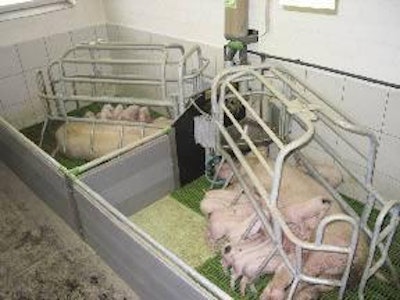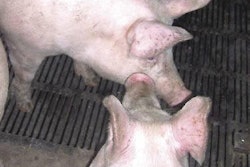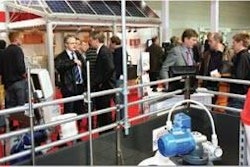
Continued pressure from soaring feed prices and low returns from slaughter of pigs has brought the exit of another 9 percent of German pig producers in the past year, with more than 7,000 units shutting shop. By May this year, the situation had left a national herd of 2.4 million breeding sows, a drop of 5 percent in 12 months. Within this new total, the number of in-pig sows and gilts has also slumped by the same percentage.
But the German sector is fighting back with a drive for more efficiency that includes new and cheaper feed components, a benchmarking programme to encourage better all-round performances, the first swine genome research for natural MMA resistance and innovations on the pork food front for increased consumption.
Silage in sow feeding
Feed is where the real pressure is, with wheat topping €200/tonne and soymeal €340/tonne this summer in Europe. Even the usual roughage components — such as wheat bran, beet pulp and ground soya pods — are more expensive than in recent history. For many producers in Germany, the feed costs situation has prompted a fresh look at the possible merits of some traditional and basic ration mixes for sows that include corn silage and cereal straw as the main roughage. Several herds in the German region of North Rhine Westphalia are being encouraged by local Chamber of Agriculture advisers to consider this route. By one account, under 5 percent of the region's sows are on silage feeding now, but it seems to be popular on the larger enterprise all of the examples involve units of 400 sows or more.
Some have reported a feed-cost saving of 17 percent or more after feeding silage again to sows. The producers find home-grown roughage much cheaper and better balanced nutritionally than bran or beet pulp. What is more, the bulkiness of straw and corn silage has helped the intestinal health of the sows and reduced troubles with constipation. Its effect of gut fill also appears to add to sow contentment.
The main problem may lie in equipment costs for the feed change. Most users save labour by pelleting the cereal straw before adding it to the feed, where their local contractor can supply grinder-pelleter machinery, but tooling-up from scratch for corn silage is an expensive business. "It is also very important that the silage quality is top class," cautions adviser Josef Bunge. "Any moulds in the silage can lead to abortions if fed to pregnant sows."
Benchmarking for better performance
Like everywhere else, successful pig producers in Germany are ambitious. All the members of the German benchmarking organisation Top Pig Farm Forum say they aim to expand their enterprises by more than 30 percent within the next five years. Already, these 116 piglet producers and 99 feeders are among the largest nationally. The forum members who are located on the eastern side of the country average 1,010 breeding sows each, compared with 281 sows per herd for those in the west.
Behind the Top Pig Farm Forum is a group of farm advisory organisations and German agricultural society DLG — also the organiser of EuroTier 2008. The target is even more efficiency at farm level to combat the modern hard times, although members already have an impressive record. On recent composite results, they average 24.3 pigs weaned per sow each year in breeding, with 766 grams per day for liveweight gain and 2.86 for feed conversion in the grow-finish section.
The national situation, reflected in results collected from 1,700 piglet producing farms (average herd size 170 sows) by the ZDS central association of German pig production, is about 22 piglets weaned per sow with the offspring averaging 720g on daily gain and 2.95 on feed conversion ratio. But results from the 10 highest-rated units in the Top Pig Farm Forum (see table) emphasise the potential for the rest to reach using the best genetics and management, when they show sow productivity at 27.6 weaned per year, daily growth at 856g and feed conversion at 2.81.
Culled sows as foster mothers
Bigger litters from modern sows can lead to more fostering of piglets to equalise suckling opportunities. In northwest Germany, more producers are allowing a temporary reprieve for sows that have been set aside to be culled from the herd — so that the animals can help out in the farrowing department as foster mothers.
Dieter Staack, an adviser with Niedersachsen consultancy VzF, links the practice to improved genetics in female lines that have added to litter size and to the uptake of batch farrowing systems by many herds. Where sows farrow in batches every two or three weeks, he observes, it is easy to take a cull sow from the previous batch and retain her for fostering duties.
The concept is gaining supporters in Germany's main piglet production areas. The timetable at each herd starts with ensuring a good intake of colostrum from the piglets' natural mothers. Litters are then rearranged before the youngsters have time to establish a suckling hierarchy at the udder. This usually means a maximum of two days after farrowing, says Dieter Staack. Older sows are never given more pigs to rear than the number they nursed successfully in their previous litters. Gilts usually have litters up to 12 or even more to stimulate milk production.
The cull sows are brought in as foster mothers towards the end of the first week. They receive the strongest piglets in the final sorting out of litters. Their selection is based on their performance record, requiring a history of at least 9-10 piglets reared per litter with a minimum of overlaying (crushing) deaths.
Hunting genes for mastitis resistance
German researchers at Kiel University are to play a leading role in swine genome analysis with the aim of identifying genetic resistance to the mastitis-metritis-agalactia (MMA) syndrome. In agreement with many animal health specialists, they believe this search for genes that can make an animal naturally resistant is the right road ahead. It offers advantages of reducing excretion of causative organisms and improving herd health and performance while also reducing antibiotic application — important for pork's public image.
Veterinary microbiologist Dr Nicole Kemper Backing leads an investigative team backed by breeding company PIC Deutschland. Samples of blood, tissue and milk from the breeder's population are being assessed along with performance records in the hope that breeding lines less susceptible to MMA diseases might be established. The German government is also supporting the "geMMA" project with a €990,000 grant over 5 years under the FUGATO (Functional Genome Analysis in Animal Organisms) programme.
The first step will be to identify MMA causative organisms in sow milk, paying special attention to E. coli and its role in the syndrome. After comparing genomes of MMA-susceptible and non-susceptible sows, the hunt will be on for genetic markers to start marker-assisted selection.
Better than a hamburger
Traditionally, pork is a popular meat in Germany. The country's average of almost 56 kilograms eaten per person every year compares with 43 kg for Europe as a whole. What worries German marketing experts is that household purchases of pork have not changed much over the last decade or more. Young people tend to think of beef hamburgers or chicken nuggets when it is time for a fast-food snack.
But the national pork sector is fighting back with two innovative pork-based snack products. One is a breaded pork from the deep-freeze cabinet that is ready to eat in four minutes. The other is a new range of pork sausage meats called high-health and low-fat. The breaded item or "Toasty" is from Tillman. This company is a processing offshoot of one of the country's largest pig slaughterers, Tönnies, where throughput amounts to 10 million pigs per year. The Toasty concept hits the wellness button with fat cut back to a maximum 9.4 percent; the protein content is double that. The 70-gram pressed pork slice is pre-cooked and comes guaranteed with no artificial flavouring or colouring. Nationwide sales are already booming, says Tillman.
Bavarian butcher Josef Pointner (backed by the national Fraunhofer scientific institute) has changed the German pork eating habit by introducing fat-free sausage meats. In fact, the pork products have less than 3 percent fat, whereas a conventional equivalent could contain 25-30 percent or sometimes more.
Pointner found that greater control of the temperature in the cutter and a cutting routine designed to free more of the meat proteins actin and myosin, improves the proteins' water-binding capacity and creates a gel that can largely replace the fat emulsion in traditional sausage-making. So, much leaner pork can be fed into the cutter. There is a drawback because the absence of the usual fatty pork cuts from the mix makes the product at least 15 percent more expensive than the standard ware. But the good news is that Germany's largest supermarket chain has already snapped up exclusive marketing rights and the high-health wurst meat, labelled vielLeicht' (a pun translating as "very low-fat") is on offer throughout Bavaria.
Preparing to be more organic
More of German pig producers have opted for the organic route in the last year. The market in 2006 had settled at around 200,000 slaughter pigs from organic systems. But, this year, there is already a potential that up to 240,000 pigs will be delivered by the country's estimated 600 organic piglet producers and feeding units.
More transparency is needed for producers supplying the growing market for bio-pigmeat. "There is no network of pricing information," explains organic pig-feeder Heinrich Rülfing from Westphalia. "This is why we have created an action group of organic pig farms." Under the title 'Aktionbündnis für Bioschweinehalter', the organisation aims to record prices offered for bio-pigmeat all over the country and also the carcase classification required by different slaughterhouses. It started with 20 members in 2007 and already has 80.
Taken together, bio-breeding farms in Germany are estimated to have 10,000 sows. But the infrastructure in place is not conducive to ultra-efficient production.
In a North Rhine Westphalia chamber of agriculture paper, organic pig production adviser Henning Niemann said a quarter of the farms had about 90 percent of sows. Almost 300 herds contained fewer than 10 females — in many cases these small units fed their own production for direct sales.
Only an estimated 0.4 percent of the German pork market is supplied by organically raised pigs. One reason could be that organic pork is often three times the price of conventional joints. This has one good point for the bio-farmers: in mid-2008, they were receiving €3-3.10/kg slaughter-weight for their animals with a 56 percent lean meat percentage while the standard slaughter pigs were about €1.30/kg. However, even the €3.00 price did not meet the extra costs associated with organic production. The need to ensure that publicity was given to the pricing situation gave Heinrich Rülfing and organic pork producers another reason for forming an action group.

















